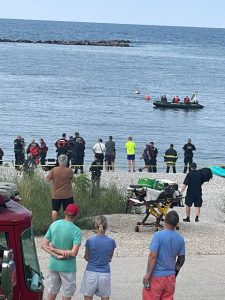
There has been much talk in the two weeks since North Vancouver’s Gray Taylor died while kiteboarding in front of Sp’akw’us Feather Park, on Canada Day afternoon.
While there may be different perspectives on what went wrong, there is no debate that this was a tragic accident that took the life of a beloved father, husband, friend and community member.
Though nothing compares to the pain his loved ones are feeling, the death of Taylor has also been traumatic for those who stepped in to try and help him, those who watched the tragedy unfold in real-time, and those who were there that day.
There is also a collective wish now to learn from what happened and hopefully prevent it from happening again.
What all those The Squamish Chief spoke to agreed on, too, is that kiteboarding is not a risk-free sport and that the wind conditions at the time of the incident were challenging, even for veteran local kiters, some of whom said they chose not to go out due to the conditions.
As for what, if anything, can be done, the municipality has launched an investigation into just that.
“In response to last week’s fatal accident, senior District staff are conducting an investigation into the factors that contributed to the accident … in close consultation with the Squamish Windsports Society as subject matter experts,” said District of Squamish director of communications, Christina Moore.
For its part, the developer of the property said it will continue to work with the parties involved regarding the watersports beach at the park, which has been temporarily closed to kiting due to the incident, since July 5.
“Since 2018, Oceanfront Squamish has worked closely with the Squamish Windsports Society and the District of Squamish on Sp’akw’us Feather Park. We are deeply saddened about the tragic accident at the park and offer our heartfelt condolences to the family and their loved ones during this incredibly difficult time,” said John Matthews, president of Matthews West Developments, in an email to The Squamish Chief.
“We will continue to support Squamish Windsports Society and the District of Squamish as they work together to determine best practices on the windsports beach.”
Asked for its perspective, the Squamish Windsports Society’s vice-president said the organization can’t comment.
“Currently, we are unable to comment on the event as we are voluntarily participating in the investigation led by the District,” said the society’s Olivier Corbeil, in an email to The Squamish Chief.
“Our focus is on understanding the incident and establishing best practices for the windsports beach. We have been collaborating closely with all involved parties and anticipate sharing more information in the coming weeks. We wish to express our gratitude to our Squamish Windsports Society team, the Good Samaritan bystanders, and emergency services for their efforts in the July 1st rescue,” he added. “Our heartfelt condolences go out to the family and friends of the deceased.”
Two veteran kiters’ perspectives
While not representative of all kiteboarders’ opinions, two locals shared with The Squamish Chief their perspectives as veteran kiters.
Christopher Rollett, who has been involved in the sport locally for a decade, including previously managing the Pepahím̓ (Spit), said that the same spot on the oceanfront was a very advanced place to launch, even before it was redeveloped, due to the wind direction.
“Basically, it’s straight onshore wind, so anything happens, you go in the direction of the wind,” he said.
“It was considered a very dangerous launch. And most people were very intimidated when they were down there. So that right off the bat, just would immediately stop a lot of people from even trying, or attempting to launch there.”
With the area’s current design, his feeling is that to prevent less advanced kiters from hurting themselves or others, kiteboarding either has to be permanently banned there or heavily managed, perhaps by the Squamish Windsports Society, which would need funding help to do so.
As for banning kiting altogether, Rollett pointed to another popular kiting location, Hood River, in Oregon. Its main launch area, right in the town, does not allow kites to launch.
“Everybody is fine with that,” Rollett said, noting that kiters are just directed to where they can launch.
In Squamish, kiters can still launch from Spit Island, with a shuttle run by the Squamish Windsports Society.
As for monitoring of the beach at the Squamish oceanfront, Rollett reiterated some direction is needed.
“There needs to be beach marshals or lifeguards there, basically telling people how to launch, where to launch, where to go in the water and what to do.”
As is clear on the signage at the watersports beach, the oceanfront spot was never intended for kiters who are not advanced.
“This is an advanced kiteboarding launch only. There are many downwind hazards with difficult onshore winds,” reads the sign at the beach site.
Doug Sage, another veteran local kiter who witnessed the accident that fateful July 1, said he didn’t go out that afternoon due to the gusty conditions.
In terms of the beach’s design, he questioned the position of the large rocks.
If they can’t be removed or reduced, then perhaps they could be covered, he said.
“Some kind of egress, like, covered with stone or gravel or, grasses or whatever, but just make it user-friendly,” he said.
“There’s got to be something done there. That’s for sure.”
Leave a Reply